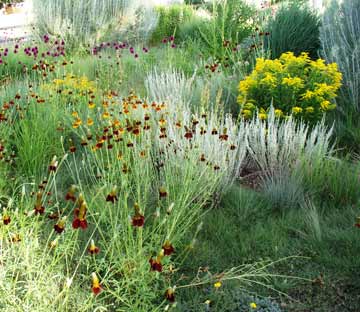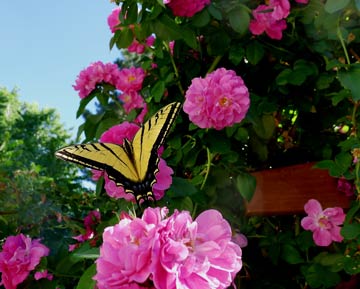The secrets to growing a garden that bends, but doesn’t break.
 Gardens filled with native perennials are better able to shrug off wind, hail, and stormy weather.
Gardens filled with native perennials are better able to shrug off wind, hail, and stormy weather.
Jodi Torpey
The saying “lightning doesn’t strike in the same place twice” is more of a wish than a true statement. Any gardener who’s had to deal with two hailstorms in one gardening season can attest to that.
Hailstorms can demolish a carefully tended landscape in mere minutes. But hail is just one weather worry. Other garden-destroying events include early and late freezes, heavy snowfalls, drenching rains, gale-force winds and scorching temperatures.
Gardeners can’t change the weather, but they can plan their landscapes with the weather in mind. Instead of planting gardens that will likely suffer from severe weather events, gardeners can choose plants that shrug off the worst of the season.
A region’s native plants are better adapted to weather whims than less hardy plants. Natives have had to survive and thrive in all kinds of weather over many years. Some plants native to North America include black-eyed Susan, bee balm, hydrangea, phlox and milkweed.
Plants that have had to survive the test of time are good choices, too. Trees, shrubs and perennials that grow on their own in open spaces, near neglected fields or around abandoned homesteads make for a weather-resistant garden. Old favorites include evergreen trees, lilac shrubs, bearded irises, and shrub roses like Harrison’s yellow.
 Cold-hardy roses, like this Canadian climbing rose, can handle all types of wild weather.
Cold-hardy roses, like this Canadian climbing rose, can handle all types of wild weather.
Jodi Torpey
Plants with narrow leaves and springy stems are known for bouncing back after storms. A few good choices include ornamental grasses, lavenders and yarrows. These plants can also withstand wild and windy weather.
In areas that naturally get little precipitation, or experience cyclical drought, select plants that won’t need much moisture to grow. Water-wise choices include salvias, sedges, and sedums and other succulents. Irises also grow well in dry conditions.
In addition to selecting native and drought-tolerant plants, here’s a few more tips for planting a weather-resistant garden:
- Plant in containers that can be moved easily when weather changes.
- Limit the number of plants with large leaves that can be shredded by wind or hail.
- Plant delicate annuals and perennials under trees or shrubs.
- Use large trees, fences and walls to block the wind and give added protection for ornamental plants.
- Keep trees and shrubs pruned to prevent branches from breaking.
- Grow a healthy landscape with regular applications of a granular plant fertilizer to help plants recover quickly from damage.
- Use thick layers of mulch (3-4 inches deep) to protect plant roots and moderate soil temperatures.
By Jodi Torpey, garden writer and author